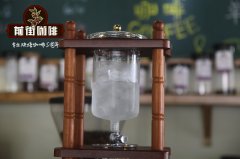Guatemala Koban Rainforest Coffee producing area introduces Koban Rainforest Coffee. Is it good to drink?

Professional coffee knowledge exchange more coffee bean information please follow the coffee workshop (Wechat official account cafe_style)
Farm: Finca San Lorenzo
Varieties: Katola, Katoi and Shakemo
Processing method: washing, drying or drying in Guardiola
Altitude: average altitude 1550 m
Boss: Valdez's family.
Town / city: San Cristobal, Altavera Paz
Region: Coban
Finca San Lorenzo is located in the cool and rainy area of Koban, Guatemala, near the town of San Cristobal Verapaz, in the verdant mountains about 1500 meters above sea level. San Lorenzo, the second farm of the Valdes family, bought our favorite Guatemalan farm, St. Isabel, as a "little brother" in 1987. When Lorenzo was first acquired, there was only a small plot of land under the coffee. Today, the family has developed 20 different plots under coffee, covering an area of 110 hectares. The remaining 35 hectares are forested and families are managing them in a very interesting way (see below).
The Valdes family has several generations of coffee growing experience. When the president of Guatemala granted the land to the Valdes family in 1875, Louis Valdes II's great-grandfather first acquired Finca San Isabel;, but when the farm was inherited by a nephew who sold it to a third party, it disappeared from the family's hands. It took a while for the farm to return to the Valdes family, and after Louis Valdes bought the farm in 1960, the Valdes family took over the farm again and brought it back to the family. In 1965, he began to run a coffee plantation.
Don Louis and his son, also known as Louis (nicknamed "Wicho"), manage the farm as general manager and agricultural manager, respectively. Another son of Louis, Rodrigo, helped run the family export business, Agricola. Valmar (Agricola Valmar). Now, the brothers' children (Louis's grandchildren) spend their school holidays on the farm, just like their father did when he was young. This is a real family business, full of love and dedication. And a lot of professional knowledge!
Don? When Don Luis first planted St. Isabel, Copan was not necessarily known for its high-quality coffee, in part because of the humid climate, coffee in the region often had to be mechanically dried. However, Don Luis and Wicho know that there is more to offer in the region. Over the past decade, they have focused on improved planting techniques and improved drying methods, successfully changing the quality of coffee and even putting Guatemala's Cup of Excellence cup twice! San Lorenzo has a lot in common with St. Isabel-maybe that's not surprising, because it's only five miles away! The cups made by Katola and Katui on the farm are no different from those of St. Isabel. In addition, about 50 per cent of San Lorenzo is grown under Sarchimor, a hybrid between Costa Rican Villa Sarchi and Timor. Because of its advantage, Hibrido de Timor, the plant is resistant to coffee leaf rust and berry or stem drilling. Growing at such a high altitude, the quality of the cup is also very good.
Wicho's agronomic background, coupled with his enthusiasm for coffee cultivation, enabled him to carry out some experimental practices in the fight against coffee leaf rust and achieved success. Both farms have implemented innovative pruning programs, which took about 15 years to test. The plan succeeded in greatly reducing the serious impact of rust on the farm. Plants are pruned in a 5-row / 5-year cycle, and then further adjusted according to the aeration and light needs of each plant. This helps reduce the use of chemical fertilizers and pest control-in some cases, halving the use of neighbors-by reducing excessive humidity and fungal diseases. In addition, the frequent use of moth worms (mainly by-products of wet treatment) has reduced their fertilizer use by more than 15%.
San Lorenzo has an annual rainfall of about 3000 mm, with 9 to 10 months of regular rainfall each year. Continuous Rain Water (mostly drizzle) means that flowering is very staggered, with 8-9 blossoms each year. Due to prolonged flowering, coffee ripens at different stages, which means that up to 10 stages (with an interval of up to 14 days) are needed to ensure that only the most mature cherries are selected.
After harvest, the red cherries are sent to the wet mill in nearby San Isabel. And then mechanically pulped. The coffee is fermented for 48 hours and covered with a lid at night to keep the temperature constant. After fermentation, wash the coffee, then soak it in clean water for 24 hours to remove any mucus and then dry it. It should be noted that the coffee from St. Isabel and San Lorenzo is processed completely separately, and each batch of coffee on the two farms has been carefully preserved.
END
Important Notice :
前街咖啡 FrontStreet Coffee has moved to new addredd:
FrontStreet Coffee Address: 315,Donghua East Road,GuangZhou
Tel:020 38364473
- Prev

Guatemala Pinnacle Coffee Manor introduction is the coffee bitter in Guatemala Pinnacle Manor?
Professional coffee knowledge exchange more coffee bean information please follow Coffee Workshop (Wechat official account cafe_style) Farm: Finca La Cumbre varieties: 100% Catuai processing: fully washed and sun-dried patio elevation: 1675-1825 meters above sea level owner: Federico Cruz Sandoval town / city: Santa Catarina Pimra and San Jose Pimra area: Fr
- Next

What's the smell of Guatemalan hand-made coffee? does Guatemalan hand-made coffee smell like smoke?
Professional coffee knowledge exchange more coffee bean information please follow Coffee Workshop (Wechat official account cafe_style) Farm: Santa Marcos Ballenka varieties: Bourbon and Keturah treatment: complete washing altitude: above 1500 meters above sea level Farmer: various small farmer towns / cities: La Barranca, Las Majadas and San Rafael Guatibil area: St. Chris
Related
- Beginners will see the "Coffee pull flower" guide!
- What is the difference between ice blog purified milk and ordinary milk coffee?
- Why is the Philippines the largest producer of crops in Liberia?
- For coffee extraction, should the fine powder be retained?
- How does extracted espresso fill pressed powder? How much strength does it take to press the powder?
- How to make jasmine cold extract coffee? Is the jasmine + latte good?
- Will this little toy really make the coffee taste better? How does Lily Drip affect coffee extraction?
- Will the action of slapping the filter cup also affect coffee extraction?
- What's the difference between powder-to-water ratio and powder-to-liquid ratio?
- What is the Ethiopian local species? What does it have to do with Heirloom native species?

